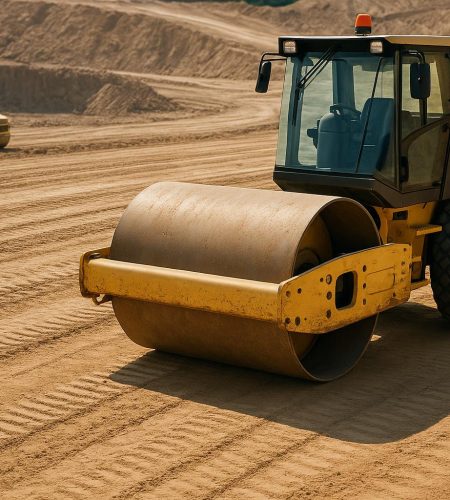When people think of site prep, they imagine excavators ripping up holes with trenches or bulldozers flattening ground. But one of the most overlooked, yet crucial machines on every construction site is in truth the road roller. Without proper compaction, no base, slab of asphalt, or embankment is capable of lasting through the years of weathering and heavy usage. In reality, studies on civil engineering have validated that weak compaction is one of the greatest causes of early pavement failure. It is high time we venture into major compaction equipment contractors rely on today and what factors to base their choice on.
Why Compaction Matters
Compaction is not merely about the flattening out of ground- it is about optimizing load-bearing ability, settlement reduction, and the elimination of water intrusion. Roads, foundation work for buildings, and heavy-industrial yards depend upon compacted earth or aggregate for structural stability.
Key goals of compaction:
- Density: Maximum dry density with minimum voids.
- Stability: Provide for the base to support dynamic and static loads.
- Longevity: Extend pavement and foundation lifespans.
Road Rollers- Heavyweight Champions of Compaction
The road roller remains the universal machine of large-scale compaction work. They are heavy drum machines- smooth, pneumatic-tyred, or vibratory- which give wide-area, high compactive effort.
Functions
- Asphalt layer completion in highways and airports.
- Fortifications and embankments.
- Sub-base and base course compaction.
Industry Practices
Contractors normally hire rollers on a short lease as rollers are rarely needed except at stipulated stages of a contract. Procurement is normally undertaken based on:
- Soil type: Cohesive clay vs. granular sand.
- Project scale: Asphalt roads need vibratory rollers, and embankment work may require sheepsfoot rollers.
- Compaction monitoring: All recent rollers are equipped with Compaction Meters to measure pass number and ground stiffness.
Skid Steer Loaders
Notably, for medium work or limited maneuverability city jobs, interstices are filled up by other plant equipment items. It’s again the skid steer loader which becomes the unlikely hero. It’s no large compactor, but it’s a most valuable asset before compaction and transporting and spreading aggregates, as well as working hydraulic attachments like trench compactors or grading blades. Rental companies describe skid steers as frequently the initial machine brought on site on smaller city jobs, since they perform several tasks before the roller gets there.
Plate Compactors The Final Cogs
At the scale’s small end, we get to the plate compactors. Portable equipment, these are smaller and less loud than a roller, but shine in the details that can either make or break project quality
Uses:
- Reducing edges of asphalt pavements where rollers cannot reach
- Preparing driveways, sidewalks, and landscaping work.
- Backfill and compact trenches-utility installations
Industry Practices
While rollers won’t typically be rented, plate compactors never will- they’re affordable, durable, and transportable, and every contractor’s inventory will have at least one. By virtue of usually being manual, operator safety is key. Repeated exposure to vibration will precipitate hand–arm vibration syndrome (HAVS), so best practice is limiting operator hours and rotational use of workers
Summarising the Essential Considerations
Road rollers dominate the scene when expansive area coverage and heavy compaction become requirements. They become prerequisites for highways, airports, and massive construction jobs wherein even stability and compaction become a promise of success. Even though the purchase cost and operating cost of road rollers is massive, the productivity offered by road rollers to massive jobs equilibrates the cost. Where budgets account for long-term applicability and large-scale production, rollers remain the core of compaction jobs.
Comparatively, skid steer loaders introduce multitasking and versatility. They may lack brute compactive energy of a roller, perhaps, but no machine multitasks better than a skid steer does—material movement, cleanup of debris, and assisting preparation before and after compaction, respectively. Mid-sized jobs or contractors who work under relatively smaller budgets will highly appreciate a skid steer loader since a machine can multitask and, due to its compactness, can be utilized on inner-city construction, wherein compactness and maneuverability become equally valuable besides productivity.
Even on the other end of the spectrum, plate compactors provide accuracy at a pinpoint level. They’re cheap, light, and an essential finish job tool—tamping edges, trenches, or tight spaces larger equipment cannot access. Applied toward smaller jobs or jobs of limited scale, plate compactors are a cost-effective purchase ensuring no soft spots get forgotten.
Lastly, contractors must juggle their work size next to budgetary constraints, time constraints, and future quality targets. It can pave the ground for a roller, but if you do not have the maneuverability of a skid steer and finishing touch of a plate compactor, you will get something less than satisfactory. True expertise lies in knowing when to deploy each piece of equipment, matching investment against project returns.

